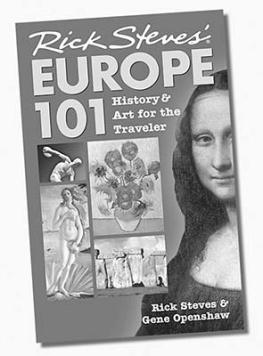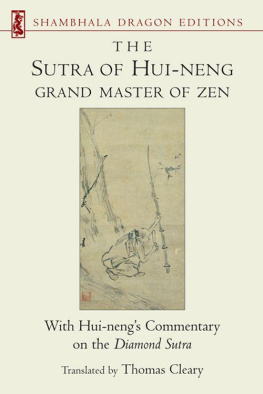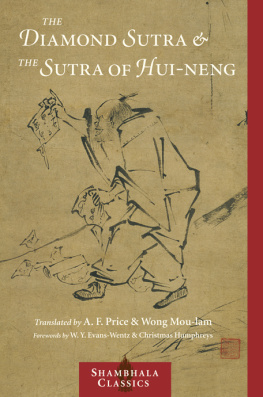There is no doubt in my mind that Thomas Cleary is the greatest translator of Buddhist texts from Chinese or Japanese into English of our generation, and that he will be so known by grateful Buddhist practitioners and scholars in future centuries. Single-handedly he has gone a long way toward building the beginnings of a Buddhist canon in English.... His translation of the Flower Ornament Sutra from Shikshanandas Chinese translation of the Sanskrit is one of the monuments in Buddhist Studies of our time.
Robert A. F. Thurman, Tricycle
As to the Avatamsaka-Sutra, it is really the consummation of Buddhist thought, Buddhist sentiment, and Buddhist experience. To my mind, no religious literature in the world can ever approach the grandeur of conception, the depth of feeling, and the gigantic scale of composition, as attained by the sutra. Here not only deeply speculative minds find satisfaction, but humble spirits and heavily oppressed hearts, too, will have their burdens lightened. Abstract truths are so concretely, so symbolically represented here that one will finally come to a realization of the truth that even in a particle of dust the whole universe is seen reflectednot this visible universe only, but a vast system of universes, conceivable by the highest minds only.
D. T. Suzuki
ABOUT THE BOOK
Known in Chinese as Hua-yen and in Japanese as Kegon-kyo, the Avatamsaka Sutra, or Flower Ornament Scripture, is held in the highest regard and studied by Buddhists of all traditions. Through its structure and symbolism, as well as through its concisely stated principles, it conveys a vast range of Buddhist teachings.
This one-volume edition contains Thomas Clearys definitive translation of all thirty-nine books of the sutra, along with an introduction, a glossary, and Clearys translation of Li Tongxuans seventh-century guide to the final book, the Gandavyuha, Entry into the Realm of Reality.
THOMAS CLEARY holds a PhD in East Asian Languages and Civilizations from Harvard University and a JD from the University of California, Berkeley, Boalt Hall School of Law. He is the translator of over fifty volumes of Buddhist, Taoist, Confucian, and Islamic texts from Sanskrit, Chinese, Japanese, Pali, and Arabic.
Sign up to learn more about our books and receive special offers from Shambhala Publications.

Or visit us online to sign up at shambhala.com/eshambhala.

The Flower Ornament Scripture
A Translation of the Avatamsaka Sutra
Thomas Cleary

SHAMBHALA BOSTON & LONDON 2014
SHAMBHALA PUBLICATIONS, INC.
Horticultural Hall
300 Massachusetts Avenue
Boston, Massachusetts 02115
www.shambhala.com
1984, 1986, 1987, 1989, 1993 by Thomas Cleary
All rights reserved. No part of this book may be reproduced in any form or by any means, electronic or mechanical, including photocopying, recording, or by any information storage and retrieval system, without permission in writing from the publisher.
Library of Congress Cataloging-in-Publication Data
Tripitaka, Stripitaka. Buddhvatasakamahvaipulyastra. English.
The Flower ornament scripture/translated by Thomas Cleary.
p. cm.
eISBN 978-0-8348-2409-6
ISBN 0-87773-940-4 (alk. paper)
I. Cleary, Thomas F., 1949 . II. Title.
BQ1622.E5T7413 1993
294.385dc20
93-21833
CIP
THE FLOWER ORNAMENT SCRIPTURE, called Avatamsaka in Sanskrit and Huayan in Chinese, is one of the major texts of Buddhism. Also referred to as the major Scripture of Inconceivable Liberation, it is perhaps the richest and most grandiose of all Buddhist scriptures, held in high esteem by all schools of Buddhism that are concerned with universal liberation. Its incredible wealth of sensual imagery staggers the imagination and exercises an almost mesmeric effect on the mind as it conveys a wide range of teachings through its complex structure, its colorful symbolism, and its mnemonic concentration formulae.
It is not known when or by whom this scripture was composed. It is thought to have issued from different hands in the Indian cultural sphere during the first and second centuries AD, but it is written so as to embrace a broad spectrum of materials and resists rigid systematization. While standard figures and images from Indian mythology are certainly in evidence here, as in other Buddhist scriptures, it might be more appropriate to speak of its provenance in terms of Buddhist culture rather than Indian culture per se. The Flower Ornament Scripture presents a compendium of Buddhist teachings; it could variously be said with a measure of truth in each case that these teachings are set forth in a system, in a plurality of systems, and without a system. The integrity of Buddhism as a whole, the specificity of application of its particular elements, and the interpenetration of those elements are fundamental points of orientation of the unfolding of the scripture.
Historicity as such is certainly of little account in The Flower Ornament Scripture. This is generally true of the Mahayana Buddhist scriptures, although they usually present their teachings as having been revealed or occasioned by the meditations of the historical Buddha Shakyamuni. In the case of The Flower Ornament Scripture, most of the discourse is done by transhistorical, symbolic beings who represent aspects of universal enlightenment. The Buddha shifts from an individual to a cosmic principle and manifestations of that cosmic principle; the Buddha in one line might be the Buddhas in the next, representing enlightenment itself, the scope of enlightenment, or those who have realized enlightenment.
Certainly one of the most colorful and dramatic rehearsals of Buddhist teachings, The Flower Ornament Scripture became one of the pillars of East Asian Buddhism. It was a source of some of the very first Buddhist literature to be introduced to China, where there eventually developed a major school of philosophy based on its teachings. This school spread to other parts of Asia, interacted with other major Buddhist schools, and continues to the present. The appreciation of The Flower Ornament Scripture was not, however, by any means confined to the special Flower Ornament school, and its influence is particularly noticeable in the literature of the powerful Chan (Zen) schools.
The work of translating from The Flower Ornament Scripture into Chinese apparently began in the second century AD, and continued for the better part of a thousand years. During this time more than thirty translations and retranslations of various books and selections from the scripture were produced. Numerous related scriptures were also translated. Many of these texts still exist in Chinese. Comprehensive renditions of the scripture were finally made in the early fifth and late seventh centuries. The original texts for both of these monumental translations were brought to China from Khotan in Central Asia, which was located on the Silk Route and was a major center for the early spread of Buddhism into China. Khotan, where an Indo-Iranian language was spoken, is now a part of the Xinjiang (Sinkiang) Uighur autonomous region in China, near Kashmir, another traditional center of Buddhist activity. The first comprehensive translation of The Flower Ornament Scripture was done under the direction of an Indian monk named Buddhabhadra (359429); the second, under the direction of a Khotanese monk named Shikshananda (652710). The latter version, from which the present English translation is made, was based on a more complete text imported from Khotan at the request of the empress of China; it is somewhat more than ten percent longer than Buddhabhadras translation.
Next page
















